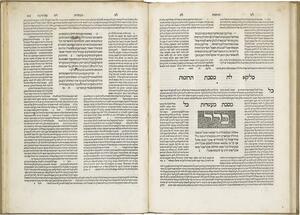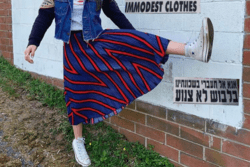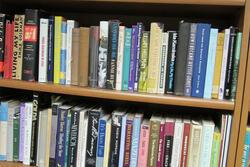"Lo Bashamayim Hi": Reconciling Feminism and Halakha
Time-bound mitzvot (commandments) have served an important role in solidifying my connection to Jewish tradition: the bubble of excitement in my stomach upon hearing the sound of the shofar on Rosh Hashanah; when I say Kiddush to bring in Shabbat; the crumbs of matzoh on my clothes during Passover. Repeated ritual solidifies connection. My ancestors valued these Jewish traditions; they immigrated to Canada from Ukraine and Morocco in order to preserve them in the shadow of persecution. In tradition’s monolithic presence, while remaining deeply dedicated to my faith, I’ve increasingly questioned where Jewish practices come from and the complexity encompassed in preservation and modernization of tradition.
I found myself at a crossroads during my freshman and sophomore years of high school. My family and day school informed my Jewish development and the rituals in which I participated for as long as I could remember. In my new school, no one was telling me how to exist as a Jew. Outside influences relenting, I was faced with the choice to take or leave the Jewish traditions I’d received. Yes, I wanted to preserve them. But I was older, too, and exploring new kinds of Judaism and engaging with a spectrum of religiosity. There were complexities in tradition and Jewish practice I’d never thought about, including my role as a woman in Judaism. In preparation for a Jewish moot court competition last year, I began studying Talmud with my friend. Along the way, Talmud became a channel for me to develop and express my Jewish feminism.
The Talmud is the central text of rabbinic Judaism, from which halakha (Jewish law) is derived. It compiles rabbinic commentary and debate on the Mishnah and the Gemara. Like most mid-to-late-antiquity Jewish texts, Talmud, as I understand it, was written down in a time when women were confined to their homes and regarded as their husbands’ property. An entire order of the Talmud, Nashim, focuses on “women’s issues.” The rabbis of the Talmud define women’s issues loosely: take Tractate Sotah, the volume that covers a man’s response to his adulterous wife, as an example; or Tractate Yevamot, which details the responsibility of a man to marry his brother’s Levite widow. Halakha pertaining to Jewish women appears throughout Talmud Bavli’s 63 tractates. Through these pages, women are acted upon by the rabbis who make laws for their existence. Subsequently, women lose their voice and their agency.
Derogatory tropes in the Talmud affect me during study. Over the summer, I taught myself a Gemara in Sotah 2a. Reich Lakish, a scholar from 200 BCE, would introduce the discussion of the Sotah (an “errant wife”) to his students by saying that Heaven matched a woman to a man according to his actions. Rashi interprets this as a “modest woman for a righteous man, a promiscuous woman for an evil man.” I am repulsed that the text objectifies a woman by employing her existence as a conduit for a man’s reward or punishment. The Gemara in Kiddushin 34b presents a question about whether or not a woman should be obligated to participate in festival rituals. Instead of reasoning that women should be obligated to participate, the Gemara decides that the mitzvah lies in a husband “gladdening” his wife, which is what inclines her to participate. The woman is thus rendered no more than an object for the purpose of a man’s performance of his religious obligations.
When I study Talmud, I hold two beliefs in tandem: the belief in the value of this text as a framework for fulfilling mitzvot; and the belief that there are limitations in this text’s portrayal of women. Talmud is partially responsible for streamlining misogyny into aspects of Jewish practice. I still believe some of the lessons and the morality it encompasses within its pages can transcend its sexism. I want the richness of this text as a guide for self-improvement to inform my Jewish practice. If sexism, which I hope can be finite, turns me away from learning Talmud, I become complicit in a tradition of women being lesser, having fewer opportunities. I believe that the only way to overcome sexism in Judaism is to fully embrace my tradition by learning it. One of the most pivotal Talmudic stories I’ve encountered is one that I learned last summer at camp called the “Oven of Akhnai” in Bava Metzia 59a-b. A new type of oven is brought to the Sanhedrin and the rabbis debate the oven’s ritual purity. Rabbi Eliezer argues it is pure and looks to “heaven” (i.e. G-d) to prove this to the rabbis. Heaven asks the rabbis why they are disagreeing, and Rabbi Joshua responds, “Lo bashamayim hi” (“[the law] is not in Heaven”).
This story holds enduring meaning in my religious and feminist development. Historically, women were not taught Talmud. Even in non-Orthodox circles, women didn’t possess equal obligation in positive time-bound mitzvot. The first female rabbi ordained by the Conservative Movement was ordained in the 1980s. This is in a tradition that is 4,000 years old. I interpret “Lo bashamayim hi” to mean that the halakha of our present and future can and must change to be relevant to our lives right now. My teachers have instilled in me that halakha, while inspired by G-d, is not divine; the law is not in heaven. The needs of today must fit under its jurisdiction. I need egalitarianism in my Jewish practice because I want to be equally obligated. I also want to know where my tradition originates and practice Judaism according to halakhic guidelines.
I do believe that some halakha is inherently misogynistic, and I respectfully won’t participate in those parts of Judaism. They don’t enrich my practice, even if I can comprehend why people choose to follow Talmudic law holistically. I am developing a unified place for halakhic tradition and feminism in my Jewish practice. It’s leading shacharit (morning prayer) in the pluralistic mechitzah minyan at school with a focus on getting to the prayers of highest halakhic value within our limited time frame. But it’s also saying the Matriarchs with pride in my Amidah and leading Kiddush at Shabbat dinner instead of lighting candles, even if that defies tradition or certain ideas in halakhic Judaism. My study of Talmud has enabled me to see that a more meaningful Jewish faith and feminist existence rests in the realization that feminism and tradition aren’t mutually exclusive.
This piece was written as part of JWA’s Rising Voices Fellowship.







So informative!
I love this!